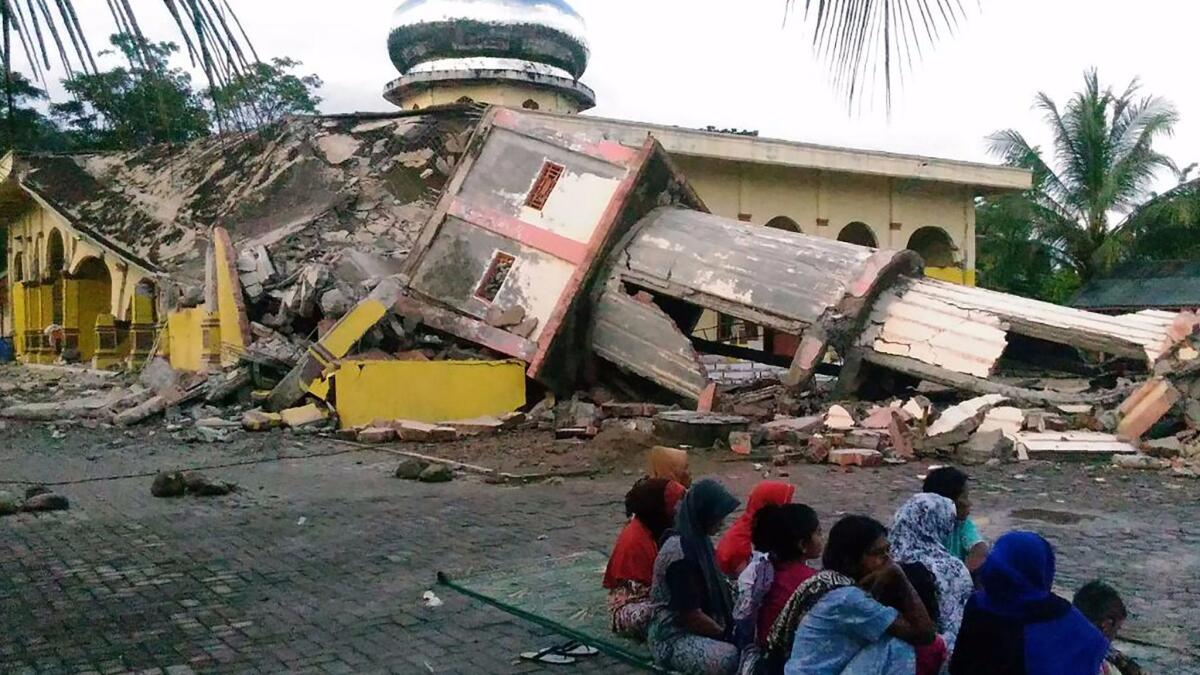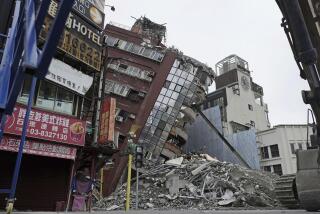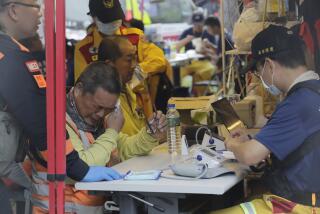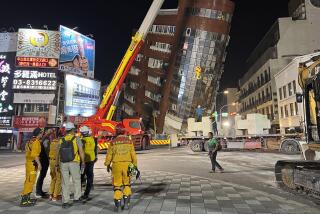Rescue crews search for survivors of deadly Indonesia quake

- Share via
Reporting from JAKARTA, Indonesia — Aid workers, soldiers and others tore through the rubble of collapsed buildings in the northwestern Indonesian province of Aceh on Wednesday in a frantic search for people trapped by an earthquake that killed more than 100 people.
Maj. Gen. Tatang Sulaiman, chief of the army in Aceh province, said four people had been pulled from the rubble alive by late Wednesday. Another four or five were still believed to be buried, but he didn’t say whether they were dead or alive.
By sundown, local disaster relief officials said the number of injured had reached 600.
The number of victims was predicted to increase “because some people are still stuck under the damaged buildings,” National Disaster Mitigation Agency spokesman Sutopo Purwo Nugroho said.
The magnitude 6.5 quake was centered about six miles north of Reuleut, a town in northern Aceh, according to the U.S. Geological Survey.
The worst damage occurred in Aceh’s Pidie Jaya district, where hundreds of people were rushed to hospitals and dozens of buildings were flattened. Local officials appealed for emergency relief supplies and heavy equipment to move debris, as well as aid in the search for survivors.
About 245 buildings were seriously damaged or destroyed, mostly in Pidie Jaya, including 14 mosques, with the remainder largely dwellings and shop houses. Roads cracked and power poles toppled over.
Pidie Jaya is less than four hours by road from the regional capital, Banda Aceh, which was leveled by the powerful 2004 earthquake and tsunami that devastated Southeast Asia, leaving nearly a quarter of a million people dead or missing across a dozen countries.
Indonesian officials said Wednesday’s quake did not have the potential to trigger a tsunami.
President Joko Widodo ordered government agencies to assist in rescue efforts and dispatched his chief of staff to Aceh to monitor the operation.
The quake struck just before dawn, when Muslims in the Aceh region, which sits on the northern tip of Sumatra island, were waking for early morning prayers.
Several buildings, including the dome of a mosque and part of an Islamic university, at least partially collapsed, Indonesian news agencies reported.
In Banda Aceh, people ran into the streets as memories of the 2004 disaster resurfaced. About half of the total deaths in the 2004 disaster were in Aceh, where a multibillion-dollar rebuilding effort took half a decade to finish.
“People felt some trauma, some were crying,” said Henry, owner of a local coffee shop chain, who, like many Indonesians, uses just one name.
“But the situation here in Banda Aceh is under control. There was no tsunami. Things are back to normal already,” he said by telephone several hours after the quake struck.
Juanda Jamal, who works for a nongovernmental agency in Banda Aceh, said people quickly realized that the temblor was not as severe as the 2004 quake.
“About 10 minutes after the earthquake we knew it was not going to cause a tsunami, and that there was not much damage here,” Jamal said.
“These days people have smartphones, Whatsapp, so the information comes more quickly and we can check that our friends and family are OK.”
The reminders of the 2004 quake are everywhere in Banda Aceh, where evacuation towers have been built and residents take part in regular escape drills. The city is home to a tsunami museum, complete with a 30-foot wall meant to simulate the size of the waves as they made landfall.
Cut Intan Damayanti, a museum staff member, was among those whose families fled their homes when Wednesday’s quake struck.
“My house is close to the coast and I felt panic [and] fear of a tsunami, as in 2004.
“But fortunately the earthquake did not cause a tsunami and we went back to the house after 30 minutes.”
Indonesia, a vast archipelago made up of thousands of volcanic islands, is prone to natural disasters because it lies in the Pacific Ocean’s “Ring of Fire,” where high tectonic activity often triggers volcanic eruptions, quakes and tsunamis.
Special correspondent Roughneen reported from Jakarta and Times staff writer Bengali from Amritsar, India. The Associated Press contributed reporting.
ALSO
Japanese leader Shinzo Abe to visit Pearl Harbor with Obama
Italy hears echoes of Trump and Brexit as anti-establishment parties press their cause
In China, American Apparel courts controversy — but not over what you’d expect
UPDATES:
4:50 a.m. Dec. 8: Updated with a new death toll.
9:10 a.m.: This article was updated with a new injury toll and a quote from a disaster relief official.
6:00 a.m.: This article was updated with an injury toll and details about the damage to buildings and roads.
2:25 a.m. Dec. 7: This article was updated with a new death toll.
11:15 p.m.: This article was rewritten throughout with staff reporting.
10:30 p.m.: This article was updated with 54 dead.
8:20 p.m.: This article was updated with a higher death toll.
This article was originally published at 5:50 p.m. Dec. 6.
More to Read
Sign up for Essential California
The most important California stories and recommendations in your inbox every morning.
You may occasionally receive promotional content from the Los Angeles Times.











